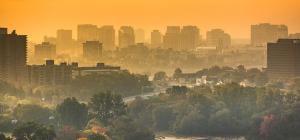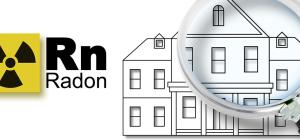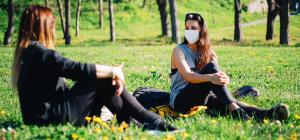
Building shutdown and re-opening during the COVID-19 pandemic
 [Last Updated: Feb 11, 2021]
[Last Updated: Feb 11, 2021]
During the ongoing COVID-19 pandemic, it may be necessary to periodically close public buildings and facilities, followed by re-opening when safe again. Periods of low or no occupancy can be challenging for building systems as deviation from standard operations may increase the risk of water system failures, fires, mould growth, pest infestation, and other complications. Reduced consumption of water can cause stagnant water to accumulate in building water systems where taps, showers, ice machines, fountains, or other water features are not in use. This can lead to reduced water quality and other hazards such as Legionella exposure once buildings are reoccupied. The risks can vary depending on the length of shutdown, building features (e.g., lead piping, presence of cooling towers, decorative water features, etc.) and whether there is routine maintenance of systems during the shutdown.
The resources provided on this topic page are intended to inform EH professionals and assist property managers with enacting a temporary closure, as well as cleaning, re-initializing, and safely operating public or commercial facilities under pandemic conditions. The resources are examples only and additional considerations may be required for specific facility types and site conditions. This information is current to the date at the bottom of the page.
NCCEH resources
- Environmental Health Resources for the COVID-19 Pandemic (NCCEH, 2020)
This topic page provides on overview of COVID-19 resources as they pertain to specific environmental health subject areas. Contents include:- Overview of transmission risks in different settings including indoor spaces, multi-unit residential buildings, shared laundry facilities, a public washrooms and performing arts
- Overview of various mitigation measures for reducing transmission risks indoors including physical barriers, air cleaning technologies, ventilation, CO2 sensors and surface cleaning and disinfection.
- Physical barriers for COVID-19 infection prevention and control in commercial settings (NCCEH, 2020)
This blog synthesizes information from public health and industry sources to provide guidance on the design, installation, and cleaning of transparent barriers or partitions intended to protect staff and clients.
- Legionella (NCCEH 2020)
This topic page provides resources for those responsible for managing water systems in buildings to understand the risks associated with exposure to Legionella bacteria and key approaches to manage Legionella risks in buildings.
- Mould (NCCEH, 2020)
This topic page provides resources on mould as an indoor air quality hazard, as well as information on assessment and mitigation.
External resources
Shifting to low- or no-occupancy operations
- COVID-19 – Building extended closure checklist (Building Owners and Managers Association of Toronto, Apr 2020)
This checklist summarizes the actions necessary to ensure a facility has been left clean, secure, and operating as necessary to prevent fires or other emergencies. Hayes Companies has provided a similar checklist with supplementary information.
- Building water systems minimum requirements – (COVID-19)(Public Services and Procurement Canada, Jun 2020)
- This guidance document specifies water temperature and flushing requirements for buildings that are being operated at low or no occupancy for more than a week.
- Building water quality and coronavirus: Flushing guidance for periods of low or no use (Environmental Science Policy Research Institute (ESPRI), Apr 2020)
This guidance document provides advice on preparing a building water system for re-occupancy. This includes recommendations for both large and small buildings with advice on flushing and other actions including inspection of equipment, cleaning and disinfection. ESPRI have also produced guidance on Reducing risk to staff flushing buildings (May 2020)
- Information on maintaining or restoring water quality in buildings with low or no use (US EPA, Jul 2020)
This website presents a guidance document for building owners or operators for maintaining water quality in buildings by minimizing stagnation during closures, and a checklist for restoring water quality for reopening.
Re-opening and operating under pandemic conditions
General resources
- Recovering from COVID-19 building closures (AIHA, 2020)
This guidance document outlines preventive measures for maintaining indoor air and water quality during shutdown and considerations for safely reopening
- Guidance for reopening buildings after prolonged shutdown or reduced operation (US Centers for Disease Control and Prevention, Sep 2020)
This webpage provides guidance on assessing and remediating mould growth, as well as mitigating for lead, copper and Legionella risks for buildings that have been shut down for days to months.
- Reopening guidance for cleaning and disinfecting public spaces, workplaces, businesses, schools, and homes (US Centers for Disease Control and Prevention, Jan 2021)
This webpage provides general guidance on cleaning and disinfecting public facilities after a prolonged closure, and on developing a sustainable, flexible long-term plan to maintain the facility in an enhanced state of cleanliness.
- Building management direction for coronavirus disease 2019 (COVID-19) (Public Services and Procurement Canada, Jun 2020)
This webpage provides an overview of functional guidance recommended for PSPC real property, with relevance to any organisation managing buildings.
- COVID-19 education response: Preparing the reopening of schools: resource paper (UNESCO, May 2020)
This resource paper synthesizes information on school closures and provides an overview of the status of school reopening globally. The document provides recommendations for policy decisions based on the timing, conditions and processes for school reopening. See also the Supplement on emerging lessons from countries managing school reopening.
- COVID-19 response – health, safety and resurgence protocols [for schools] (UNESCO Jan 2021) This toolkit focusses on practical recommendations for managing safe return to schools, as well as monitoring and preparing for a possible resurgence.
Restoring and maintaining water quality
- Guide for maintaining building plumbing after an extended vacancy (Government of Ontario, Aug 2020)
This guidance document outlines measures to reduce risks to water quality following an extended building vacancy and provides recommendations for restoring water quality based on building size.
- Responding to water stagnation in buildings with reduced or no water use: A framework for building managers (American Water Works Association, Oct 2020)
This guidance document provides a decision-making framework for building operators and managers to respond to periods of building shutdown and water stagnation, with a focus on reducing growth and potential exposures to Legionella bacteria.
- Recommendations for restoring service to water distribution systems in vacant buildings (Government of Quebec, 2020)
This guidance document outlines key concerns associated with extended stagnation of water systems and provides recommendations for restoring water quality based on building size.
- Safely re-opening buildings: A fact sheet for building owners/operators (Canadian Water and Wastewater Association, May 2020)
This factsheet explains the risks of stagnant water in buildings operating at low or no occupancy, including the risks of microbial growth, heavy metal leaching, and disinfection by-product formation, and provides detailed guidance on developing a risk mitigation and reopening strategy.
- Guidance for managing Legionella in building water systems during the COVID-19 pandemic (European Society for Clinical Microbiology and Infectious Diseases (ESGLI), 2020)
ESGLI has produced guidance documents for various types of buildings. The link above provides guidance applicable to hotels, campsites, cruise ships, residential and office buildings with similar water systems. Guidance is also available specific to dental practices, with dental unit water lines, nursing & care homes and hospitals.
- Making a splash with safe water (CDC, Feb 2020)
This fact sheet provides a reminder for hotels and resorts of where Legionella can grow and spread in buildings including cooling towers, unoccupied floors, hot tubs, decorative fountains, or during events that can interrupt normal water supply.
- Considerations for large building water quality after extended stagnation (Proctor et al. Jun 2020)
This literature review by researchers at Purdue University, Centre for Plumbing Safety, summarizes challenges, current practices and knowledge gaps for recommissioning water systems following extended periods of reduced use. The document refers to existing guidance on building commissioning, and start-up following seasonal shutdowns as examples of current practice to reduce health risks.
Restoring and maintaining air quality
- Preparing HVAC systems before reoccupying a building (McCarthy and Coghlan, ASHRAE, Jan 2021)
This technical brief outlines the key steps for moving HVAC systems from no to low use to full occupancy following a prolonged shutdown. Measures include inspection, maintenance and testing, and assessing the implications of new operational settings, such as increasing outdoor air intake, for reducing COVID-19 transmission risks.
- Ventilation in buildings (US Centres for Disease Control and Prevention, Dec 2020)
This webpage lists ventilation related mitigation measures for reducing transmission risks of COVID-19 indoors and FAQs on ventilation and COVID-19.
- Heating, ventilation and air-conditioning systems in the context of COVID-19: first update (European Centre for Disease Prevention and Control, Nov 2020)
This technical report provides an overview of the role of HVAC as a mitigation measure for COVID-19 transmission, as well as a review of relevant HVAC guidelines from EU/EEA countries and the UK.
- Transmission from HVAC systems (Alberta Health Services, Jun 2020)
This expert panel reviewed the available literature on SARS-CoV-2 transmission in hospital and non-hospital settings.
- Building HVAC operational best practices. Advancing better indoor air quality in the age of COVID-19 (BOMA Toronto, Oct 2020)
This guidance document summarizes best practices for the operation of HVAC systems to mitigate transmission risk and improve indoor air quality.
This list is not intended to be exhaustive. Omission of a resource does not preclude it from having value.








